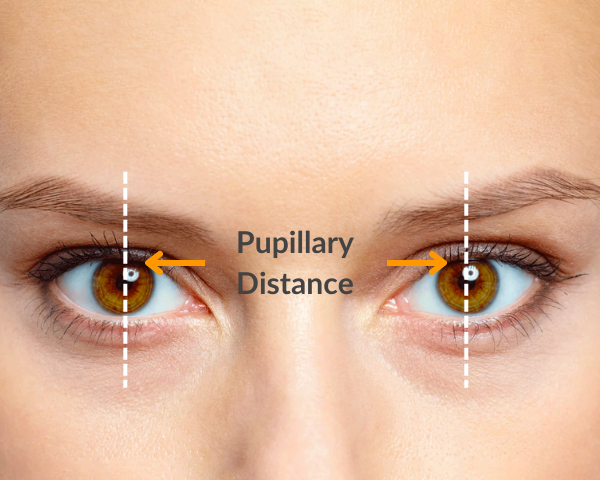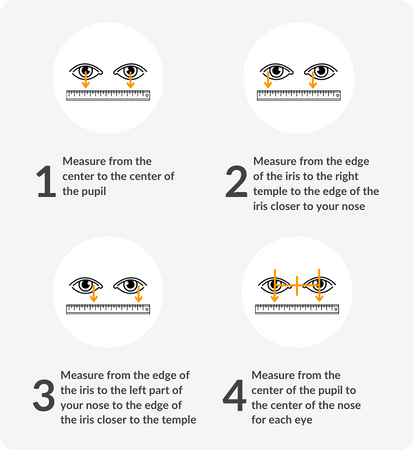What is Pupillary Distance?
Why PD is important | Measuring PD yourself | Measuring PD online | Measuring PD at home | Standard PD | Monocular and Binocular PD | Accuracy

Reviewed by
Beck JinnettePupillary distance is the distance between your pupils. Read our guide on what it is, and how to measure it.

If you’re planning on placing your first order of prescription glasses online, it may initially seem a little intimidating. Coming across terms like pupillary distance (PD) and not knowing what it is can be frustrating. That is why we’ve put together an easy guide to everything you need to know about reading your pupillary distance.
Pupillary distance is the distance between your pupils and is crucial knowledge when fitting your prescription eyewear. To have the clearest vision, the distance between the centre of the left lens and the right lens should be the same as the distance between your pupils.
Why pupillary distance is important
Pupillary distance (PD) is an important step in getting glasses as it helps lens makers determine the centre of your lenses. The monocular PD measures each eye separately and lets the eyeglass maker see exactly how much space there should be between your eyes for optimum viewing performance. When you measure your pupillary distance, you provide eyeglass makers with essential information needed to make sure your vision correction will be perfect for you.
It can take only a few seconds to write down or snap a photo of your PD, but if you don’t get this correct during an eye exam, it could mean the difference between clear vision and a distorted lens. That’s why measuring the pupillary distance carefully is key to getting the best vision possible out of your new pair of glasses or contact lenses.
Can you measure pupillary distance yourself?
The pupillary distance can be found at the bottom of your prescription card, as your eye doctor or specialist usually measures it. However, it could be the case that there is no pupillary distance in your prescription because your doctor did not include it or you didn’t realize you had to ask for it. In that case, you can easily retrieve the measurements using an online tool or do it yourself with the help of a mirror and a ruler.
Measure your pupillary distance online
Our free pupillary distance app is the best option for getting pupillary distance online. We recommend this option as it’s fast, easy and accurate. All you need for our online tool is a smartphone, a webcam and a magnetic strip card. The app has voice instructions that will guide you through each step of PD measurement. Head to our website and see how easy it is
DID YOU KNOW?
Pupillary distance is an important measurement to know when fitting glasses. You can easily measure it yourself at home or online without going to a professional.
How to measure your PD at home
If you don’t have access to the tools required to use our app, you can easily measure your PD by yourself. All you need is a ruler and a mirror on standby.
- Standing in front of a mirror, hold the ruler up to the bridge of your nose or against the line of your eyebrows.
- Close your right eye. While looking in the mirror, align the ruler’s zero with your left pupil.
- Keeping the ruler still, close your left eye and open your right eye.
- Read the number aligned with your right pupil’s centre. This number is your first pupillary distance measurement.
- Repeat the process to ensure you get the most accurate measurement result.
If you are struggling to follow these steps, enlisting the help of a friend could make things easier. All you need to do is stand facing your friend and ask them to measure your PD using either a ruler or a millimeter tape measure. Both of you can repeat the steps outlined above, with your friend holding the ruler to the bridge of your nose and taking the measurement. During this, the person assisting you must make sure their own head is very straight.

What is a standard pupillary distance?
Pupillary distance is different for each individual. The average adult’s pupillary distance is between 54 and 74 mm, while the average pupillary distance for children is between 41 and 55 mm. Since a person’s pupillary distance changes with physical development, it is important to consider that children may have different pupillary distances each year.
What is the difference between Monocular and Binocular PDs?
Monocular PD measures only one eye – usually the dominant eye – while Binocular PD measures both eyes to obtain a more accurate PD measurement. Considering that most frame styles need both eyes’ measurements for optimal comfort and fit, Binocular-PD measurement should be preferred over Monocular-PD measurement when selecting glasses.
Plus, as modern frames come in numerous sizes and shapes, such as cat-eye, it may not always be possible to replicate a fitting accurately with just one measurement from a frame you previously owned. Measure twice to ensure a perfect measurement!
How accurate does my pupillary distance have to be?
Pupillary distance has to be as accurate as possible to ensure you’re getting the best out of your prescription glasses. If you’re in doubt or have questions, head to our Optical Centre for more information and speak to one of our opticians online today.
What is Pupillary Distance?
Why PD is important | Measuring PD yourself | Measuring PD online | Measuring PD at home | Standard PD | Monocular and Binocular PD | Accuracy

Reviewed by
Beck Jinette
If you’re planning on placing your first order of prescription glasses online, it may initially seem a little intimidating. Coming across terms like pupillary distance (PD) and not knowing what it is can be frustrating. That is why we’ve put together an easy guide to everything you need to know about reading your pupillary distance.
Pupillary distance is the distance between your pupils and is crucial knowledge when fitting your prescription eyewear. To have the clearest vision, the distance between the centre of the left lens and the right lens should be the same as the distance between your pupils.
Why pupillary distance Is important
Pupillary distance (PD) is an important step in getting glasses as it helps lens makers determine the centre of your lenses. The monocular PD measures each eye separately and lets the eyeglass maker see exactly how much space there should be between your eyes for optimum viewing performance. When you measure your pupillary distance, you provide eyeglass makers with essential information needed to make sure your vision correction will be perfect for you.
It can take only a few seconds to write down or snap a photo of your PD, but if you don’t get this correct during an eye exam, it could mean the difference between clear vision and a distorted lens. That’s why measuring the pupillary distance carefully is key to getting the best vision possible out of your new pair of glasses or contact lenses.
Can you measure pupillary distance yourself?
The pupillary distance can be found at the bottom of your prescription card, as your eye doctor or specialist usually measures it. However, it could be the case that there is no pupillary distance in your prescription because your doctor did not include it or you didn’t realize you had to ask for it. In that case, you can easily retrieve the measurements using an online tool or do it yourself with the help of a mirror and a ruler.
Measure your pupillary distance online
Our free pupillary distance app is the best option for getting pupillary distance online. We recommend this option as it’s fast, easy and accurate. All you need for our online tool is a smartphone, a webcam and a magnetic strip card. The app has voice instructions that will guide you through each step of PD measurement. Head to our website and see how easy it is.
DID YOU KNOW?
How to measure your PD at home
If you don’t have access to the tools required to use our app, you can easily measure your PD by yourself. All you need is a ruler and a mirror on standby.
- Standing in front of a mirror, hold the ruler up to the bridge of your nose or against the line of your eyebrows.
- Close your right eye. While looking in the mirror, align the ruler’s zero with your left pupil.
- Keeping the ruler still, close your left eye and open your right eye.
- Read the number aligned with your right pupil’s centre. This number is your first pupillary distance measurement.
- Repeat the process to ensure you get the most accurate measurement result.
If you are struggling to follow these steps, enlisting the help of a friend could make things easier. All you need to do is stand facing your friend and ask them to measure your PD using either a ruler or a millimeter tape measure. Both of you can repeat the steps outlined above, with your friend holding the ruler to the bridge of your nose and taking the measurement. During this, the person assisting you must make sure their own head is very straight.

What is a standard Pupillary Distance?
Pupillary distance is different for each individual. The average adult’s pupillary distance is between 54 and 74 mm, while the average pupillary distance for children is between 41 and 55 mm. Since a person’s pupillary distance changes with physical development, it is important to consider that children may have different pupillary distances each year.
What is the difference between Monocular and Binocular PDs?
Monocular PD measures only one eye – usually the dominant eye – while Binocular PD measures both eyes to obtain a more accurate PD measurement. Considering that most frame styles need both eyes’ measurements for optimal comfort and fit, Binocular-PD measurement should be preferred over Monocular-PD measurement when selecting glasses.
Plus, as modern frames come in numerous sizes and shapes, such as cat-eye, it may not always be possible to replicate a fitting accurately with just one measurement from a frame you previously owned. Measure twice to ensure a perfect measurement!
How accurate does my pupillary distance have to be?
Pupillary distance has to be as accurate as possible to ensure you’re getting the best out of your prescription glasses. If you’re in doubt or have questions, head to our Optical Centre for more information and speak to one of our opticians online today.






































